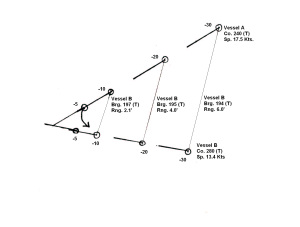The Charity
Aviation
Maritime
Near Collision 1

Initial Report
CHIRP Comment: The following incident has been reported to CHIRP by a company wishing to share its experience with others. The Maritime Advisory Board welcomes this report and wishes to encourage other companies to share their incident data in circumstances where they believe others might benefit.

Company Preamble: One of our ships had a Near Miss (collision). The facts are as reported by the Master. (His comments are unprintable). The report was circulated to our fleet with my comments appended. The Duty Officer concerned was a properly certificated officer. He was the Third Mate carrying out the Second Mate’s watch (1200 to 1600) as the Master had just sacked his Second Mate for incompetence and was sailing short handed for one voyage. The Master had kept the 0800 to 1200 watch himself and handed over to the other officer at 1200 but was still on the Bridge.
Report Text:
Time : 12:30 Ships time
Wx : Sea slight Wind BF 3 Vis Good
Location: Vessel approaching TSS.
No navigational danger or ship within 5 NM on stbd side. Other ship being tracked on radar since 11:45. ARPA indicates other ship crossing ahead of Own Ship TCPA 10 mins, CPA 0.35 NM ahead. Master on Bridge. Duty off came and stood on steering position close to helmsman. Duty Off alters course to Port. Other ship maintains course and speed. Own Ship passes very close astern of other vessel (ARPA shows CPA as zero). There has been no communication with the other vessel, the VTS or with the Master who was standing on the Bridge wing a few feet away.
Company Comment: It is not the intention to explain the collision regulations; however, the action taken by the duty officer is a clear violation of Rules 15 & 17 of the Collision Regulations. a) Rule 15 (Crossing Situation). This makes Own Ship the Stand-on vessel. b) Rule 17 (Action by Stand-on Vessel). Own Ship is required to hold her course and speed. A power driven vessel which takes action to avoid collision “shall if the circumstances of the case admit, not alter course to port for a vessel on her port side”.
If the Duty Officer was concerned about the other vessel, he should have made efforts to contact her. Further, with the Master standing close by he also failed to express his concern to the Master and finally compounded the error by altering course to Port in direct contravention of Rule 17 (c).
Notwithstanding the presence of the Master on the bridge, the Duty Officer remains in charge of the vessel unless relieved. However, Duty Officers are required to keep the Master advised of any navigational hazards or developing close quarter situations. If an officer does not seek the assistance of the Master standing close by when he feels there is a risk of collision, would this officer call the Master at night?
For some reason, it is a common practice among young officers to alter course to port in crossing situations as above and also in head-on situations or near head-on situations governed by Rule 14.
Please discuss this case with your deck officers and ensure that they are fully aware of:-
(i) The dangers in alterations of course to port when taking action in accordance with Rule 14 or Rule 17(c).
(ii) Their obligation to call the Master whenever in doubt. The guiding principle should be “If in doubt whether you are in doubt – call the Master”.
CHIRP Comment:
The Maritime Advisory Board considered the Company’s comments and believes the following additional points and information may add value to the analysis of this incident:
• The ARPA indicated the other vessel was passing ahead (even if closely) and there is a risk that this apparent accuracy may have had an impact on the judgement of the OOW and Master.
• Guidance on acceptable passing distances in the Company and/or Master’s Standing Orders may have been of assistance.
• The sound and light signals prescribed by Rule 33(d) should have been made. As a general rule VHF should not be used in collision avoidance.
• At no time does a reduction in speed appear to have been considered as an option.
• The Master was clearly experiencing some difficulties with the officer complement and could have used this situation as a training/mentoring opportunity instead of permitting it to develop.
• If the Company has identified that incorrect alterations to port are common place in the circumstances outlined, then it should consider taking steps to identify why this is the case and identify appropriate remedial measures, such as a fleet circular backed up with additional assessment and training.
• The acceptable action in this case would have been a large alteration of course to starboard in accordance with Rule 17(c) (a round turn) or a reduction in speed.







